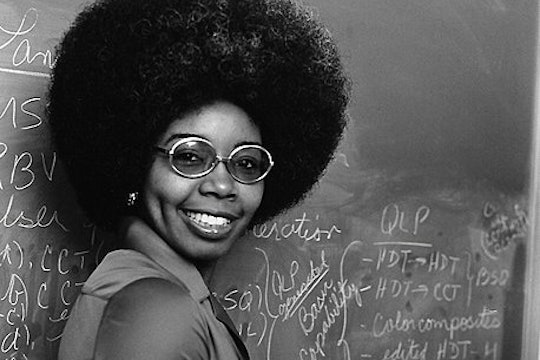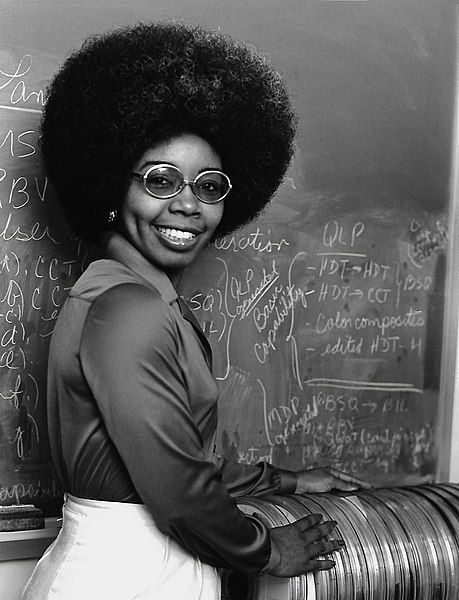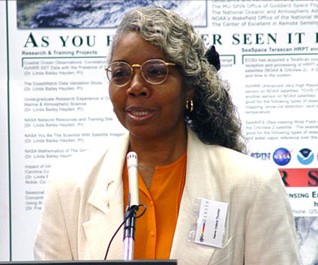
NASA on Wikimedia Commons (public domain)
Meet Valerie Thomas, the inventor and scientist who launched the longest-running satellite program imaging Earth’s surface
During Thomas's three-decade career at NASA, she connected scientists with the data they need to understand our planet
Valerie Thomas retired from NASA in 1995 after three decades of work, and she left with a legacy as a trailblazing scientist and creative inventor. More than 20 years later, her contributions and her dedication to teaching and uplifting underrepresented youth in her field are still making an impact.
Thomas was born in Maryland in February of 1943. Despite an early interest in mechanics that she shared with her father, Thomas was not encouraged to pursue her passion for science and math. When an eight-year-old Thomas brought home a library book called The Boy's First Book On Electronics, she hoped her father would help her work on the projects like he tinkered with TV sets, but he did not. Regardless, she went on to attend Morgan State University in Baltimore, Maryland, a historically Black university, as one of two women majoring in physics in her class.

Valerie Thomas next to a stack of early Landsat Computer Compatible Tapes in 1979
NASA on Wikimedia Commons (public domain)
After graduating with honors from Morgan State, Thomas accepted a job as a data analyst at NASA in 1964. There, she was introduced to the world of computing, a natural extension of her interests in physics and math. “When I started work at NASA, I had not seen a computer except in science fiction movies,” Thomas said in a 2019 interview. “Since my job involved writing computer programs, I decided to learn as much as possible about computers.”
In her first role at NASA, Thomas worked on translating data captured by Orbiting Geophysical Observatory satellites, including information about gamma and ultraviolet radiation, into formats that scientists could understand and use.
A greater challenge came in 1970, when Thomas began working on the Landsat program (originally called the Earth Resources Technology Satellite), managed jointly by NASA and the United States Geological Survey. Landsat satellites capture multispectral images of Earth from orbit, meaning they gather data along various parts of the electromagnetic spectrum. This provides visual, infrared, thermal, and other information about the Earth’s surface and atmosphere. Landsat was the first program to make multispectral imaging of Earth widely available to scientists, who use the data for applications from tracking water use to predicting crop yields.
Thomas managed development of the image processing software that translated the raw data transmitted from the satellites into formats usable for all kinds of applications. She also worked with the digital tapes that contained early Landsat data, called Computer Compatible Tapes. She saw a need to bridge the gap in understanding between the complex digital data on the tapes and the knowledge levels of scientists who were trying to use it. Thomas became the go-to person to consult about Landsat data, and eventually consolidated her knowledge into a document that became indispensable for scientists using the data.
Thomas took on a greater role in one specific application of Landsat, the Large Inventory Crop Area Experiment (LACIE). This ambitious program demonstrated that Landsat data could be used to predict global crop yields, and the study was completed in only five months. Thomas managed a team of about 50 people in the LACIE program, overseeing the research, development, hardware, and software needed to identify wheat fields across the world using Landsat images.
Landsat has now provided continuous data about Earth’s surface and atmosphere for nearly half a century since the first satellite was launched in 1972, making it an incredible resource. Especially as the rate of global climate change has accelerated, an objective and relatively high-resolution record of deforestation, urbanization, glacial melting, and other processes is invaluable. The most recent satellite in use, Landsat 8, launched in 2013, and its successor Landsat 9 is set to launch this month.
Thomas was also an inventor. In 1976, she saw a demonstration involving a lightbulb that led to her own lightbulb moment. The exhibit demonstrated an illusion in which the lightbulb appeared to glow even after it had been unscrewed from a lamp, using a concave mirror reflecting a second, hidden lightbulb to achieve this effect. “That caught my attention. I went up close to touch the light bulb. When I tried to touch it, my finger went right through what appeared to be a bulb,” Thomas said in an interview earlier this year. She went to the library, where she read that the illusion relied on optics principles she had learned about in her physics education. Excited by the possible implications of such technology for NASA and beyond, Thomas got to work developing her own invention and applied for a patent for an "illusion transmitter" in 1978.
The illusion transmitter itself is deceptively simple. It consists of two concave, or inwardly curved, mirrors, which can be located in separate places, each observed by an image processor such as a video camera. An object is placed in front of one mirror, and the reflection of the object in the curved mirror is captured by the first camera. On the receiving end, the partner camera projects the received image onto its own mirror. The image reflected in a concave mirror reaches each eye at a different angle. The observer’s brain combines the two images, creating an optical illusion that the object appears three-dimensionally in front of the mirror. Although other methods of transmitting three-dimensional illusions existed at the time, Thomas’ invention was unique in its simplicity.

Valerie Thomas speaks at 2003 event at Elizabeth City State University
Thomas’s patent for the illusion transmitter was granted in 1980. Only a small fraction of United States patents belong to Black inventors, and even fewer are held by Black women. The illusion transmitter is used by NASA today, and Thomas has imagined further applications in video, television, and even surgical imaging.
During the rest of her three-decade career at NASA, Thomas continued to manage projects such as the Space Physics Analysis Network, which increased connectivity between computer systems and became an integral part of the early internet. She rose through the ranks to become associate chief of the Space Science Data Operations Office. For her important work developing NASA technologies and facilitating connections between scientists around the world, NASA awarded Thomas the Goddard Space Flight Center Merit Award and the Equal Opportunity Medal.
But science is not her only passion — Thomas also cares a great deal about educating and inspiring young scientists, especially girls, women, and Black students like herself. She became involved with professional and educational organizations for minority and female scientists, including the National Technical Association, Science Mathematics Aerospace Research and Technology, Inc., and Women in Science and Engineering. In her final years at NASA, Thomas was integral to developing the Minority University-Space Interdisciplinary Network, enabling students at minority-serving institutions to connect and work with NASA scientists. Today, she is the president of her regional chapter of Shades of Blue, an organization promoting students’ interests in aviation and aerospace careers.
Thomas describes herself as a “lifetime learner,” and during her time at NASA she went on to earn her master’s and doctoral degrees. She is not only a learner but a lifelong teacher, too: Thomas now works as a substitute teacher at a high school in the Baltimore area, and her students Google her many accomplishments. Thomas’ contributions to NASA programs, her dedication to facilitating connection and sharing information among researchers, and her continued outreach work have impacted and inspired scientists, students, and people around the world.
